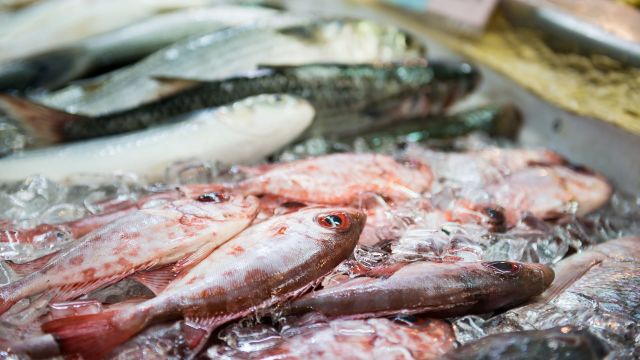We’ve all heard the warnings—seafood favorites like ahi and ono may be a healthy source of protein and omega-3 fatty acids, but they also contain a hidden danger: mercury. It’s hard to imagine anything potentially harmful could be in your regular poke bowl, but certain types of fish are high in mercury and other dangerous chemicals that consumers should be aware of. We sat down with Diana Felton, MD, State Toxicologist in Pearl City, to learn more about the risks.
The bigger the fish, the greater the risk
Mercury is a naturally occurring element that gets into the world’s waterways through both natural and man-made sources. “It starts out as metallic, or what we call inorganic mercury,” explained Dr. Felton. “Then it gets converted to methylmercury, or what we call organic mercury, by the sediments in the water, by the fish's chemistry.” This conversion happens when bacteria and microorganisms react with inorganic mercury. That means the kind of mercury in fish isn’t the same kind of mercury as what you would find in an old-school thermometer.
Mercury can enter fish when they eat algae and other organisms that contain methylmercury. It accumulates in a fish’s body over time, but not all fish have a significant amount. As bigger fish eat smaller fish, the larger fish accumulate more mercury. “It's the fish at the top of the food chain that are the ones that are going to have the most mercury,” warned Felton. Swordfish, kajiki and shark, for example, all tend to have higher levels.
Who should worry?
For the average fish consumer in Hawaii, the mercury levels in seafood do not pose a significant threat. The people who do need to be very aware of mercury levels in seafood are women who are pregnant, may become pregnant or are breastfeeding, as well as children under age 10. The EPA goes so far as to say that any women of childbearing age (about 16-49) should avoid high mercury fish as mercury will accumulate in your bloodstream over time and leaves the body slowly. It could take a full year for mercury levels to drop in your body from a period of eating a lot of high mercury fish.
“We have pretty good evidence that methylmercury is bad for the developing brain,” said Felton. Because of that, Felton suggests eating smaller fish that are usually lower in mercury.
Pregnant women shouldn’t forgo all seafood though. “It’s about the balance. We know fish is good for pregnant women, the omega-3s are good for the developing brain, but the mercury is dangerous. The best thing to do in this case is to eat fish lower in mercury,” explained Felton.
To help local women understand what types of seafood are best to eat during pregnancy or while breastfeeding, the DOH created a brochure that explains healthy seafood consumption. Cooking does not remove mercury, meaning these guidelines aren’t just for raw fish. One great tip is to eat fish that are small enough to fit into a frying pan whole, as smaller fish tend to be lower in mercury.
More than mercury: other seafood contaminants
While mercury in fish can be alarming, Felton warned that it isn’t the only contaminant found in seafood. Polychlorinated biphenyls (PCBs) also pose a threat. PCBs are man-made organic chemicals that were produced for industrial and commercial use in the mid 20th century. They are considered to be a potential carcinogen and may have other potential negative impacts on your health. Pregnant women should also avoid high PCB exposure as it may lead to decreased birth weight and gestational age.
“Not only do they stick around in the environment for a really long time and take a long time to break down, but they stick to organic particles. They stick to sediment and soil and they also bioaccumulate in fish,” said Felton. Larger predator fish will not only have higher levels of methylmercury, but they’ll also have more PCBs.
Thankfully, fish with high levels of PCBs in Hawaii tend to group in relatively small areas. For example, Felton mentioned a small area in Kaneohe Bay near the Marine Corps Base Hawaii on Oahu where high levels of PCBs had been found. When that happened, the Department of Health, along with MCBH, issued a warning to local fishermen and instituted a catch-and-release program in that area to help ensure people did not consume contaminated fish. The DOH will issue warnings to fishermen whenever high levels of PCBs are found in the soil or fish around the islands.
The DOH can’t check every fishing spot, so if you’re concerned about PCBs getting into your locally caught seafood, Felton recommended eating only certain parts of the fish: “If you remove the organs and the fat, you remove a large percentage of the PCBs in the fish.”
Be seafood smart
Fish and other seafood have been a vital resource to Hawaii since the first Polynesian voyagers settled here. They’re still a healthy and often cost-effective part of a local diet, particularly for those who catch their own. Varying the type of fish you eat and selecting smaller fish are good ideas for limiting mercury and PCB exposure.
For adults who aren’t pregnant, planning to be pregnant, or breastfeeding, Felton recommends sticking to the USDA’s Dietary Guidelines for Americans 2015-2020 suggestion to consume seafood about two to three times, or 8 to 12 ounces, a week.






